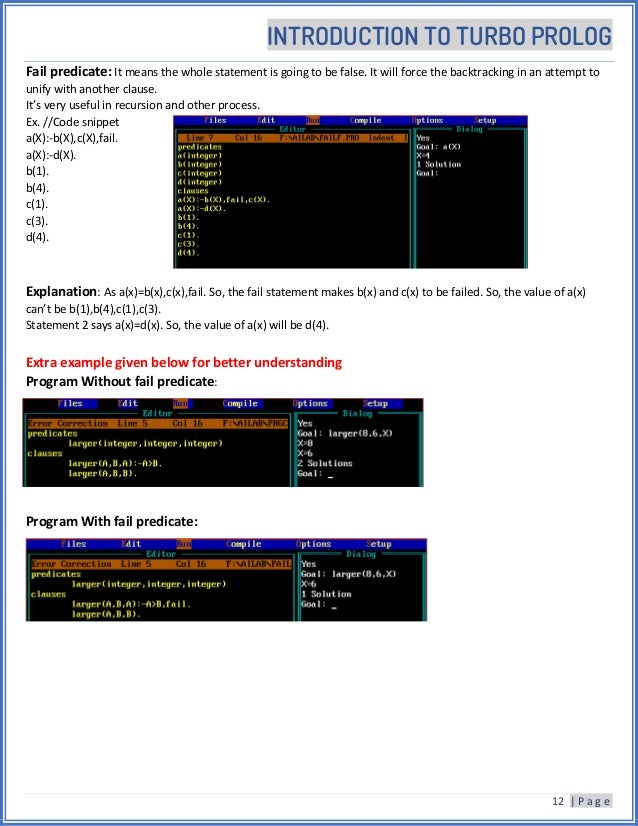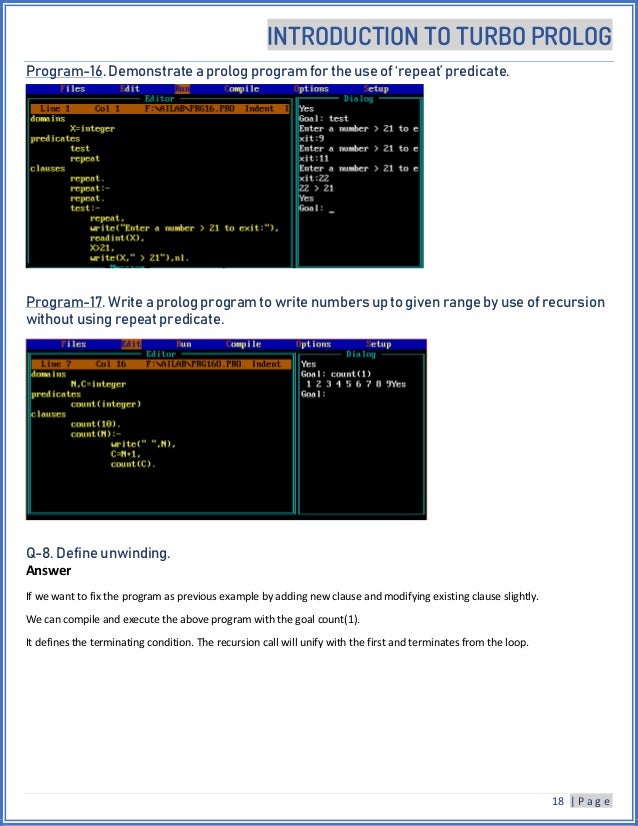1. How to Run Prolog
The examples in this Prolog Tutorial were developed using either Quintus Prologrunning on Digital Equipment Corporation MicroVAXes (ancient history) or using SWI Prologon either Sun Sparks (long ago), in Windows on a PC (a while ago), or (recently) under the OS X operating system on a Mac.B-Prolog for Mac Free to try KopecSoft Mac OS X 10.4/Intel, Mac OS X 10.5/Intel, Mac OS X 10.6/Intel, Mac OS X 10.7/10.8/10.9 Version 8.1 Full Specs Download Now Secure Download. How to Run Prolog The examples in this Prolog Tutorial were developed using either Quintus Prolog running on Digital Equipment Corporation MicroVAXes (ancient history) or using SWI Prolog on either Sun Sparks (long ago), in Windows on a PC (a while ago), or (recently) under the OS X operating system on a Mac. TURBO toggle is an Autocad plugin designed to switch AutoCAD to a faster mode by customizing all the relevant variables. The TURBO toggle switches AutoCAD 2012, 2011, 2010, 2009, 2008 or 2007 to a faster mode by presetting a couple of relevant system. TurboCAD Mac offers complete 2D and 2D/3D CAD solutions for Mac users. TurboCAD Mac Deluxe and Designer are versatile tools for beginners, while TurboCAD Mac Pro provides professional architectural and mechanical design tools with photorealistic rendering. SWI-Prolog offers a comprehensive free Prolog environment. Since its start in 1987, SWI-Prolog development has been driven by the needs of real world applications. SWI-Prolog is widely used in research and education as well as commercial applications. Join over a million users who have downloaded SWI-Prolog.
Other important prolog systems (Borland, XSB, LPA, Minerva ...) have been used for development and testing over the past 25 years. A new section of this tutorial is planned to describe prolog systemsin a general way, but that section is not available at this time.
SWI-Prolog's website has lots of information about SWI-Prolog, a downloadarea, and documentation. The upkeep for SWI-Prolog is excellent. The link ...
SWI-PrologHome Page (current as of August 2006)
The examples in this tutorial use a simplified form of interaction witha typical Prolog interpreter. The sample programs should executesimilarly on any system using an Edinburgh-style Prolog interpreter orinteractive compiler.
To start an interactive SWI-Prolog session under Unix, open a terminal window andtype the approprite command (indicated in the installation instructions). For example, on our Mac this is ...
$ /opt/local/bin/swipl
{We never type that last line: we employ Unix source files to start SWI-Prolog using additional command line arguments and/or switches for special purposes.The reader could explore this possibility soon after learning more prolog basics.}
Under Windows, SWI-Prolog installs a start icon that can be double-clickedto initiate the interpreter. The interpreter then starts in its own command window.
A startup message or banner may appear, and that will soon be followed bya goal prompt looking similar to the following
?- _Interactive goals in Prolog are entered by the user following the '?- ' prompt.
Many Prologs have command-line help information. SWI Prolog hasextensive help information. This help is indexed and guides the user. Tolearn more about it, try
?- help(help).Notice that all of the displayed symbols need to be typed in, followedby a carriage return.
To illustrate some particular interactions with prolog, consider thefollowing sample session. Each file referred to is assumed to be a localfile in the user's account, which was either created by the user, obtainedby copying directly from some other public source, or obtained by savinga text file while using a web browser. The way to achieve the latter iseither to follow a URL to the source file and then save, or to select textin a Prolog Tutorial web page, copy it, paste into a text editor windowand then save to file. The comments /* ... */ next to goals are referredto in the notes following the session.
The comments appearing at the right at various spots in a samplesession were added with a text processor. They also serve as referencesignposts for the notes which appear below. We discuss several points now, while other details will be deferred to later sections.Notes:
1. A Prolog goal is terminated with a period '.' In this case the goalwas to load a program file. This 'bracket' style notation dates back tothe first Prolog implementations. Several files can be chain loaded bylisting the filenames sequentially within the brackets, separated by commas.In this case, the file's name is 2_1.pl (programs corresponding to Section7.1 of this tutorial), which contains two prolog programs for calculatingthe factorial of a positive integer. The actual program in the file isdiscussed in Section 2.1. The program file was located in the current directory.If it had not been, then the path to it would have to have been specifiedin the usual way.


Turbo Prolog For Windows 10
2. The built-in predicate 'listing' will list the program in memory --in this case, the factorial program. The appearance of this listing isa little different than the appearance of the source code in the file,which we will see in Section 2.1. Actually, Quintus Prolog compiles programsunless predicates are declared to be dynamic. Compiled predicates do nothave an interactive source listing that can be supplied by a 'listing'goal. So, in order to illustrate this Prolog interpreter feature, the predicateswere declared as dynamic in the source code before this sample run.
3. The goal here, 'factorial(10,What)', essentially says 'the factorialof 10 is What?'. The word 'What' begins with an upper-case letter, denotinga logical variable. Prolog satisfies the goal by finding the value of thevariable 'What'.
4. Both 'programs' now reside in memory, from the two source files 2_1.pland 2_7.pl. The 2_7.pl file has many list processing definitions in it.(See Section 2.7.)
5. In the program just loaded is a definition of the logical predicate'takeout'. The goal 'takeout(X,[1,2,3,4],Y)' asks that X be taken out oflist [1,2,3,4] leaving remainder list Y, in all possible ways. There arefour ways to do this, as shown in the response. The 'takeout' predicateis discussed in Section 2.7. Note, however, how Prolog is prodded to produceall of the possible answers: After producing each answer, Prolog waitswith a cursor at the end of the answer. If the user types a semicolon ';', Prolog will look for a next answer, and so on. If the user just hitsEnter, then Prolog stops looking for answers.
6. A compound or conjunctive goal asks that two individual goals besatisfied. Note the arithmetic goal (built-in relation), 'X>3'. Prologwill attempt to satisfy these goals in the left-to-right order, just asthey would be read. In this case, there is only one answer. Note the useof an anonymous variable '_' in the goal, for which no binding is reported('don't-care variable').
7. The 'halt' goal always succeeds and returns the user to the operatingsystem.
Prolog Tutorial ContentsMulti paradigm programming language
Visual Prolog is a multi paradigm programming language based on the logical language Prolog. The goal of Visual Prolog is to facilitate programmatic solutions of complex knowledge emphasized problems.
Turbo Prolog For Mac Versions
Visual Prolog is a powerful and type safe high level programming language combining the very best features of logical, functional and object-oriented programming paradigms in a consistent and elegant way. With Visual Prolog you can build applications for the Microsoft Windows 32/64 platforms.
Prolog Tutorial Pdf
It supports advanced client-server and three-tier solutions. Visual Prolog is especially well suited for dealing with complex knowledge. By utilizing the powerful object system you are able to architect your application very rigidly and at the same time benefiting from very loose coupling. This will enable you to reduce development and even more maintenance cost.
